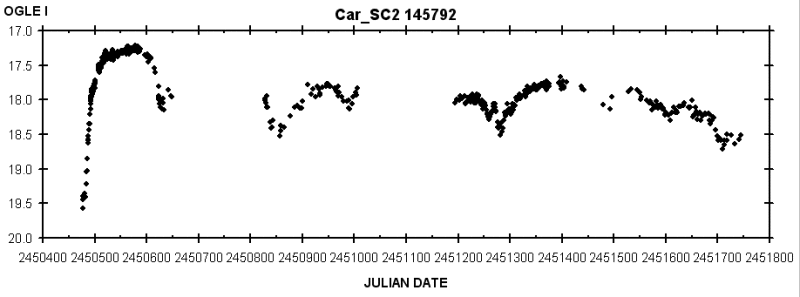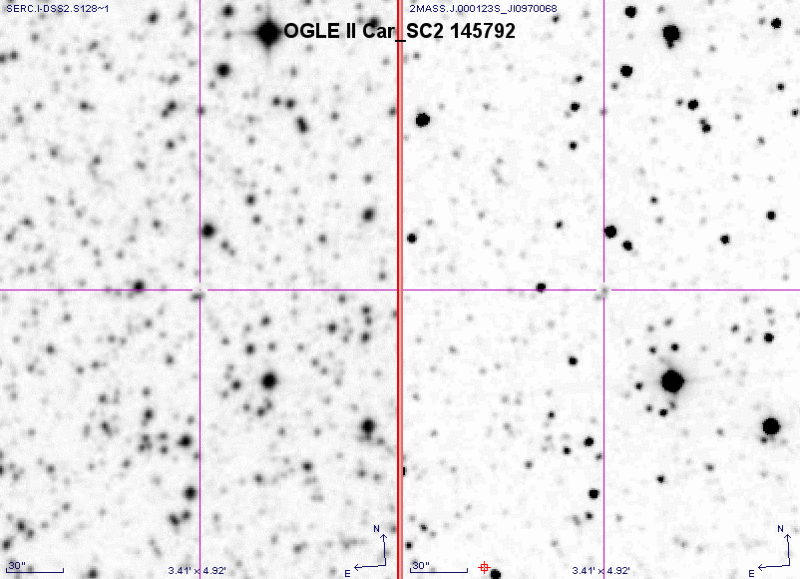| Article in PDF |
"Peremennye Zvezdy", Prilozhenie, vol. 8, N 38 (2008) |
Possible Faint Slow Nova in Carina in 1997
J. Greaves
Northants, England, UK
| ISSN 2221–0474 |
Received: 25.08.2008; accepted: 10.11.2008
(E-mail for contact: bydra@safe-mail.net)
| ||||||||||||||||||||||
Remarks: |
| Wils (2008) noted that OGLE II Photometric Database Galactic Disc data (Szymanski
2005; Udalski et al. 1997) revealed a possible slow nova in Carina in 1997.
A search of SERC/AAO and ESO plates using the CDS Aladin server shows no object of this kind on various colour plates for dates prior to this time. However, interstellar extinction in these fields is large (estimated at E(B-V) ~ 2.7 and Av ~ 8.5 by the IRSA/IPAC Dust Extinction service) which is probably best illustrated by a May 2000 SuperCosmos Halpha image of JD 2451675.76 when the OGLE II data show the object to be I magnitude ~ 18.5 yet nothing is visible there on the SuperCosmos Halpha plate to a limit of 20th to 21st magnitude. Therefore the N or near infrared emulsion I band plates are better evidence, and neither a SERC 1981.14 nor SuperCosmos 1982.33 dated I band plates show any indication of the object down to limiting magnitudes of around I 19 to 20 as determined from adjacent catalogued faint field stars. Nor is it detected in DENIS gunn i on March 28th 1999 (JD 2451265.654479) whilst a nearby star was just limit detected to magnitude 17.1, however this is not unexpected as the OGLE data show it was I magnitude roughly 18.1 that time. It does however appear in both the 2MASS and the DENIS catalogues J and Ks data, and the former shows it well in images, especially in the Ks band. In both catalogues J is approximately 11.2 and Ks approximately 14.0, ie J-Ks ~ 2.8, despite a 301 day difference. However, the OGLE II I magnitude had returned to 18.0 at that time (January 23rd 2000, JD 2451566.80), little different from that of the OGLE magnitude at the date of the DENIS data (above). The object is not entirely clearly a Nova, although it does show some similarities to classical Slow Novae Nova Delphini 1967 (HR Del) and a similar modern object Nova Cassiopeiae 1995 (V723 Cas): an initial long, flat topped, with occasional small flares, maximum is followed by a long and very slow decline. However, in the case of this object whenever a fuller decline commences some resurgence occurs such that object averages a plateau between roughly I magnitudes 18 and 18.5 for well over two years. Yet a slow and relatively steep initial outburst rise taking almost a month to get near peak magnitude, but climbing from fainter than magnitude 19.5 reveals an outbursting object somewhat disimilar to an EXOR, which could also be expected in these star forming regions. No recent deep images of this area appear to be readily available by which to examine the state of the object currently. |
| References: |
| Szymanski, M., 2005, Acta Astronomica, 55, 43
Udalski, A., Kubiak, M., Szymanski, M., 1997, Acta Astronomica, 47, 319 Wils, P., 2008, private communication |
Light Curve
OGLE II Car_SC2 145792 OGLE I band Lightcurve from January 28th 1997 to July 18th 2000 Finding Chart 
Data Source |